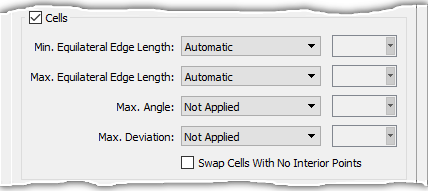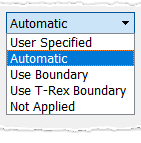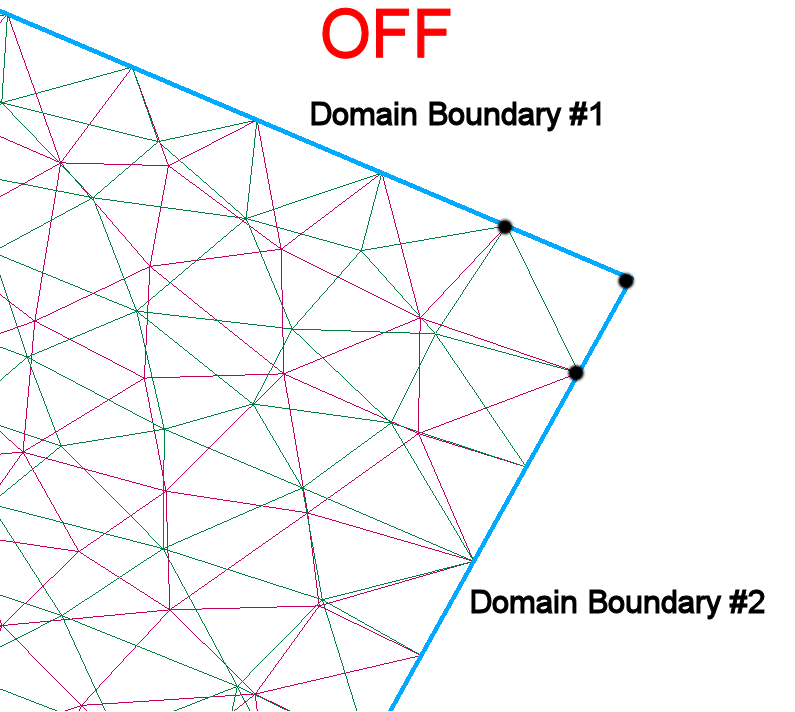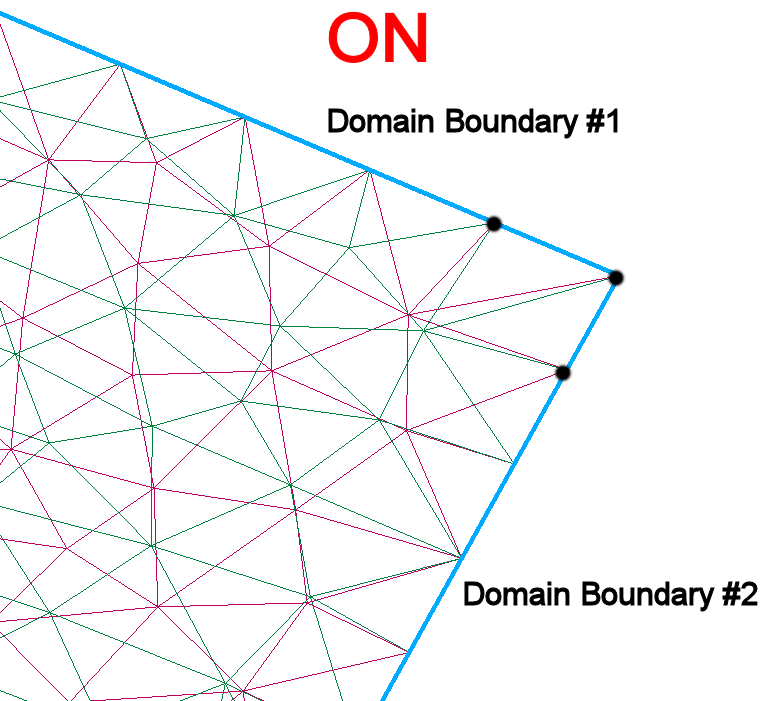Description
The unstructured domain solver's grid control parameters provided in the Cells frame (see figure below) allow you to establish the criteria by which the solver decides whether and how to modify the isotropic portion of a domain.

Note: The attributes in the Cells frame have no impact if the Algorithm is set to Thin Surface Interpolation. However, they are still used when Thin Surface Interpolation cannot be applied and the Algorithm defaults to Advancing Front Ortho.
The Min. Equilateral Edge Length parameter controls the lower edge length limit of triangular and quadrilateral cells. This parameter is used primarily as a safeguard to avoid a potential excessive refinement of the surface grid driven by the combined effects of the other parameters. The unstructured domain solver computes the area of an equilateral cell (triangular or quadrilateral as appropriate) with an edge length equal to the target Min. Equilateral Edge Length. The computed equilateral area is then compared to the area of actual cells in a domain. If the area of the actual cells in a region of a domain are sufficiently smaller than the computed equilateral area, the actual cells in that region are decimated.
Analogously, the Max. Equilateral Edge Length parameter controls the upper edge length limit of triangular and quadrilateral cells. The unstructured domain solver computes the area of an equilateral cell (triangular or quadrilateral as appropriate) with an edge length equal to the target Max. Equilateral Edge Length. The computed equilateral area is then compared to the area of actual cells in a domain. If the area of the actual cells in a region of a domain are sufficiently larger than the computed equilateral area, the actual cells in that region are refined.
The Min. Equilateral Edge Length and Max. Equilateral Edge Length pull-down lists contain five identical options each that will determine how the target value for these parameters should be computed:

- User Specified: Sets the Min. Equilateral Edge Length/Max. Equilateral Edge Length target value to the value entered in the associated text field.
- Automatic: If the Max. Angle and Max. Deviation curvature-based clustering parameters are not defined, this option sets the Min. Equilateral Edge Length/Max. Equilateral Edge Length target value to either Use T-Rex Boundary or Use Boundary depending on whether a domain contains anisotropic (i.e. T-Rex) cells or not respectively. On the other hand, if either the Max. Angle and/or Max. Deviation curvature-based clustering parameters are defined, this option sets the target value to Not Specified.
- Use Boundary: Sets the Min. Equilateral Edge Length/Max. Equilateral Edge Length target value to the minimum/maximum edge length of the connectors bounding a domain.
- Use T-Rex Boundary: If a domain contains T-Rex cells, this option sets the Min. Equilateral Edge Length/Max. Equilateral Edge Length target value to the minimum/maximum edge length in the final T-Rex front.
- Not Specified: No Min. Equilateral Edge Length/Max. Equilateral Edge Length target value is specified. In this case, no lower/upper edge length limit is imposed to the cells in the surface grid.
The Max. Angle parameter lets you specify the maximum allowable angle between the normal to an unstructured surface cell and the normal to its underlying database surface. A point will be inserted into a cell if the estimated maximum angle between the normal at the cell's centroid and the vertex surface normals lying on the database exceeds the specified maximum angle. By default, the maximum angular deviation is not applied (value equal to zero). The parameter is only applied to domain grids that are constrained to database surfaces.
The Max. Deviation parameter lets you specify the maximum allowable distance the discrete domain can deviate from the underlying database surface. A point will be inserted into a cell if the estimated maximum distance between the cell's centroid and the underlying database surface exceeds the specified maximum surface deviation. By default, the maximum surface deviation is not applied (value equal to zero). The parameter is only applied to domain grids that are constrained to database surfaces.
The Swap Cells With No Interior Points option controls edge swapping when three points lie on domain boundaries. In the figure below, two domains (rendered in green and purple respectively) will be created that share boundaries at a corner. With this option toggled off, one single triangle will be created using the three points on the domain boundaries. As a result, the two domains look as if they collapse at the corner. Toggle on this option to prevent triangles with two edges on domain boundaries from being created.

